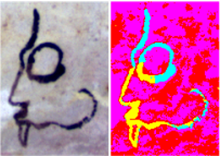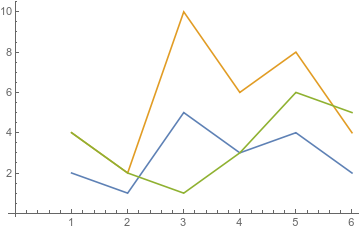


Fang Face - 6D angle between vectors
How can we determine if cave markings on a wall were made with different materials?

The image looks all black to the human eye. So we use cameras designed to capture wave lengths that we can't see, and take 6 different snap shots (capturing different types of information). For each pixel in the picture, the cameras record six numbers. We can think of these numbers as a 6D vectors, such as the 3 simplified vectors below.
- $\vec v_1 = (2, 1, 5, 3, 4, 2)$
- $\vec v_2 = (4, 2, 10, 6, 8, 4)$
- $\vec v_3 = (4, 2, 1, 3, 6, 5)$

How do we recognize if two vector represent the same material? First, note that the numbers increase proportionally with brightness. Can you tell that $v_2$ is twice $\vec v_1$? Let's compute angles between the vectors using the law of cosines $$\vec u\cdot\vec v = |\vec u||\vec v|\cos\theta.$$
- Compute the angle between $v_1$ and $v_2$.
- Compute the angle between $v_1$ and $v_3$.
Rapid Recall
- A rover is travelling on the line $\vec r(t) = (a,b)t+(c,d)$. Let $\vec v =(a,b)$ and let $P=(c,d)$. An anomaly is located at $Q=(m,n)$. Which of the following gives the distance between the rover's location and the anomaly as a function of time?
- $|\vec Q-\vec v|$
- $|\vec Q-\vec r|$
- $|\vec Q-\vec P|$
Solution
The rover's location is $\vec r$, and the anomaly is at $Q$, so a vector from the position to the anomaly is $\vec s = \vec Q-\vec r$. The length of this vector is $|\vec Q-\vec r|$.
- Continuing from before, let $\vec s$ be the vector from the rover's current position to the anomaly, so $\vec s = \vec Q-\vec r$. Which of the following gives the angle between the direction the rover is traveling and the anomaly.
- $\ds\cos^{-1}\left(\frac{\vec v\cdot \vec s}{|\vec v||\vec s|}\right)$
- $\ds\cos^{-1}\left(\frac{\vec r\cdot \vec s}{|\vec r||\vec s|}\right)$
- $\ds\cos^{-1}\left(\frac{\vec P\cdot \vec s}{|\vec P||\vec s|}\right)$
Solution
The rover's direction of motion is $\vec v$, and a vector from the position to the anomaly is $\vec s = \vec Q-\vec r$. The angle between these is $$\ds\cos^{-1}\left(\frac{\vec v\cdot \vec s}{|\vec v||\vec s|}\right).$$
- Given the vectors $\vec F$ and $\vec d$ on the board, draw the projection of $\vec F$ onto $\vec d$.
Solution
I'll draw this on the board
- If $\vec F=(6,7)$ and $\vec F_{\parallel \vec d} = (2,-1)$, then what is $\vec F_{\perp \vec d}$?
Solution
Since $\vec F_{\parallel \vec d}$ and $\vec F_{\perp \vec d}$ must sum to $\vec F$, then $\vec F_{\perp \vec d} = \vec F - \vec F_{\parallel \vec d} = (6,7)-(2,-1) = (4,8)$. Note that $\vec F_{\parallel \vec d} \cdot \vec F_{\perp \vec d}=0$ which should be the case (why?).
- The force $\vec F = (3,5)$ acts on an object which undergoes a displacement $(-2,1)$. Find the work done by $\vec F$ though this displacement.
Solution
Work is given as the dot product of $\vec F$ and $\vec d$. Thus, $W=(3,5)\cdot(-2,1)=-6+5=1$.
Group problems
- The projection of $\vec F$ onto $\vec d$ is $(3,0)$. Give two vectors $\vec F$ and $\vec d$ so that this can occur.
- Give a different pair $\vec F$ and $\vec d$ with the same projection.
- Repeat the previous problem, assuming that $\text{proj}_{\vec d}{\vec F} = (-1,2)$.
- Let $x=2u+3$ and $y=4v-5$. Complete the $u,v,x,y$ table below, and then construct a graph of both $u^2+v^2=1$ (in the $uv$-plane) and the corresponding equation in the $xy$-plane. $$ \begin{array}{c|c|c|c} u&v&x&y\\\hline 0&0&3&-5\\ 1&0&5&-5\\ 0&1&&\\ -1&0&&\\ 0&-1&&\\ \end{array} $$
- Draw the three circles $x^2+y^2=1$, $(x-2)^2+(y-5)^2=1$, and $(x+2)^2+(y+3)^2=1$.
- Draw $\left(\frac{x}{3}\right)^2+\left(\frac{y}{5}\right)^2=1$.
- Draw $\ds \frac{(x-2)^2}{16}+\frac{(y-3)^2}{9}=1$.
- Draw $\ds \frac{(x-2)^2}{16}-\frac{(y-3)^2}{9}=1$.
- Draw $\ds \frac{(y-3)^2}{9}-\frac{(x-2)^2}{16}=1$.
|
Sun |
Mon |
Tue |
Wed |
Thu |
Fri |
Sat |
